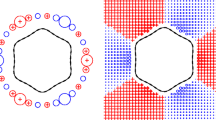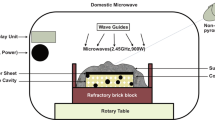Abstract
The design of inductors in electromagnetic shaping of molten metals consists in looking for the position and the shape of a set of electric wires such that the induced electromagnetic field makes a given mass of liquid metal acquire a predefined shape. In this paper we formulate an inverse optimization problem where the position and shape of the inductors are defined by a set of design variables. In a first formulation of the inverse optimization problem we minimize the difference between the target and the equilibrium shapes while in a second approach we minimize the L 2 norm of a fictitious surface pressure that makes the target shape to be in mechanical equilibrium. Geometric constraints that prevent the inductors from penetrating the liquid metal are considered in both formulations. The optimization problems are solved using FAIPA, a line search interior-point algorithm for nonlinear optimization. Some examples are presented to show the effectiveness of the proposed approaches.
Similar content being viewed by others
References
Achtziger W (2007) On simultaneous optimization of truss geometry and topology. Struct Multidiscipl Optim 33(4–5):285–304
Allaire G (2007) Conception optimale de structures, mathématiques and applications, vol 58. Springer, Berlin
Arora JS, Wang Q (2004) Optimization of large-scale structural systems using sparse SAND formulations. Tech. rep., Optimal Design Lab/CCAD, College of Engineering/4110 SC, The University of Iowa, Iowa City, IA 52242
Arora JS, Wang Q (2005) Review of formulations for structural and mechanical system optimization. Struct Multidiscipl Optim 30(4):251–272
Brancher JP, Séro-Guillaume OE (1985) Étude de la déformation d’un liquide magnétique. Arch Ration Mech Anal 90(1):57–85
Canelas A, Herskovits J, Telles JCF (2007) Shape optimization using the boundary element method and a SAND interior point algorithm for constrained optimization. Comput Struct 86(13–14):1517–1526
Canelas A, Roche JR, Herskovits J (2008) The inverse electromagnetic shaping problem. Struct Multidiscipl Optim. doi:10.1007/s00158-008-0285-9
Choi KK, Kim NH (2004) Structural sensitivity analysis and optimization 1 and 2. Springer, Berlin Heidelberg New York
Coulaud O, Henrot A (1994) Numerical approximation of a free boundary problem arising in electromagnetic shaping. SIAM J Numer Anal 31(4):1109–1127
Felici TP, Brancher JP (1991) The inverse shaping problem. Eur J Mech B Fluids 10(5):501–512
Fu HZ, Shen J, Liu L, Hao QT, Li SM, Li JS (2004) Electromagnetic shaping and solidification control of Ni-base superalloys under vacuum. J Mater Process Technol 148(1):25–29
Gagnoud A, Etay J, Garnier M (1986) Le problème de frontière libre en lévitation électromagnétique. J Méc Théor Appl 5(6):911–934
Haftka RT (1985) Simultaneous analysis and design. AIAA J 23(7):1099–1103
Haftka RT, Kamat MP (1989) Simultaneous nonlinear structural analysis and design. Comput Mech 4(6):409–416
Henrot A, Pierre M (1989) Un probléme inverse en formage de métaux liquides. Modél Math Anal Numér 23(1):155–177
Henrot A, Brancher JP, Pierre M (1989) Existence of equilibria in electromagnetic casting. In: Proceedings of the fifth international symposium on numerical methods in engineering. Comput Mech, vol 1, 2 (Lausanne, 1989). Southampton, pp 221–228
Herskovits J (1998) Feasible direction interior-point technique for nonlinear optimization. J Optim Theory Appl 99(1):121–146
Herskovits J, Laporte E, Le Tallec P, Santos G (1996) A quasi-Newton interior point algorithm applied to constrained optimum design in computational fluid dynamics. Rev Européenne Élém Finis 5(5–6):595–617
Herskovits J, Mappa P, Goulart E, Mota Soares CM (2005) Mathematical programming models and algorithms for engineering design optimization. Comput Methods Appl Mech Eng 194(30–33):3244–3268
Kress R (1999) Linear integral equations, applied mathematical sciences, vol 82, 2nd edn. Springer, New York
Moffatt HK (1985) Magnetostatic equilibria and analogous Euler flows of arbitrarily complex topology I Fundamentals. J Fluid Mech 159:359–378
Murat S, Simon J (1976) Sur le contrôle par un domaine géométrique. Tech rep 76015, Laboratoire d’Analyse Numérique, Université de Paris
Nédélec JC (1977) Approximation des équations intégrales en mécanique et en physique. Tech rep, Centre de mathématiques appliquées, Ecole Polytechnique
Novruzi A (1997) Contribution en optimization de formes et applications. PhD thesis, Université Henri Poincaré, Nancy 1
Novruzi A, Pierre M (2002) Structure of shape derivatives. J Evol Equ 2(3):365–382
Novruzi A, Roche JR (1995) Second order derivatives, Newton method, application to shape optimization. Tech. Rep. RR-2555, INRIA
Novruzi A, Roche JR (2000) Newton’s method in shape optimisation: a three-dimensional case. BIT 40(1):102–120
Pierre M, Roche JR (1991) Computation of free surfaces in the electromagnetic shaping of liquid metals by optimization algorithms. Eur J Mech B Fluids 10(5):489–500
Pierre M, Roche JR (1993) Numerical simulation of tridimensional electromagnetic shaping of liquid metals. Numer Math 65(2):203–217
Pierre M, Rouy E (1996) A tridimensional inverse shaping problem. Comm Partial Differ Equ 21(7–8):1279–1305
Roche JR (1996) Algorithmes numériques en optimization de formes et électromagnétisme, mémoire d’Habilitation à Diriger des Recherches
Roche JR (1997) Gradient of the discretized energy method and discretized continuous gradient in electromagnetic shaping simulation. Appl Math Comput Sci 7(3):545–565
Séro-Guillaume OE, Zouaoui D, Bernardin D, Brancher JP (1992) The shape of a magnetic liquid drop. J Fluid Mech 241:215–232
Shercliff JA (1981) Magnetic shaping of molten metal columns. Proc R Soc Lond A 375:455–473
Simon J (1980) Differentiation with respect to the domain in boundary value problems. Numer Funct Anal Optim 2(7–8):649–687
Sneyd AD, Moffatt HK (1982) Fluid dynamical aspects of the levitation-melting process. J Fluid Mech 117:45–70
Sullivan CR (1999) Optimal choice for number of strands in a Litz-wire transformer winding. IEEE Trans Power Electron 14(2):283–291
Yi SI, Shin JK, Park GJ (2008) Comparison of MDO methods with mathematical examples. Struct Multidiscipl Optim 35(5):391–402
Zhiqiang C, Fei J, Xingguo Z, Hai H, Junze J (2002) Microstructures and mechanical characteristics of electromagnetic casting and direct-chill casting 2024 aluminum alloys. Mater Sci Eng A 327(2):133–137
Zouaoui D, Séro-Guillaume OE, Brancher JP (1990) Equilibrium of a magnetic liquid drop: variational approach and computation. Magn Gidrodin 26(4):32–35, 150
Author information
Authors and Affiliations
Corresponding author
Rights and permissions
About this article
Cite this article
Canelas, A., Roche, J.R. & Herskovits, J. Inductor shape optimization for electromagnetic casting. Struct Multidisc Optim 39, 589 (2009). https://doi.org/10.1007/s00158-009-0386-0
Received:
Revised:
Accepted:
Published:
DOI: https://doi.org/10.1007/s00158-009-0386-0




